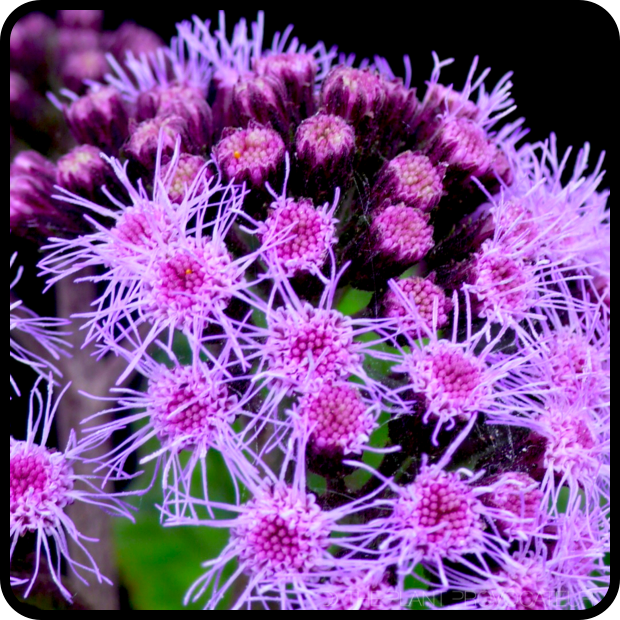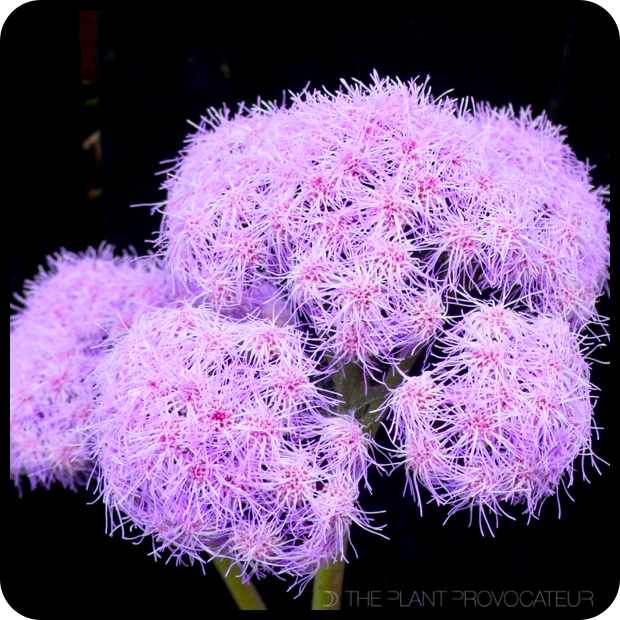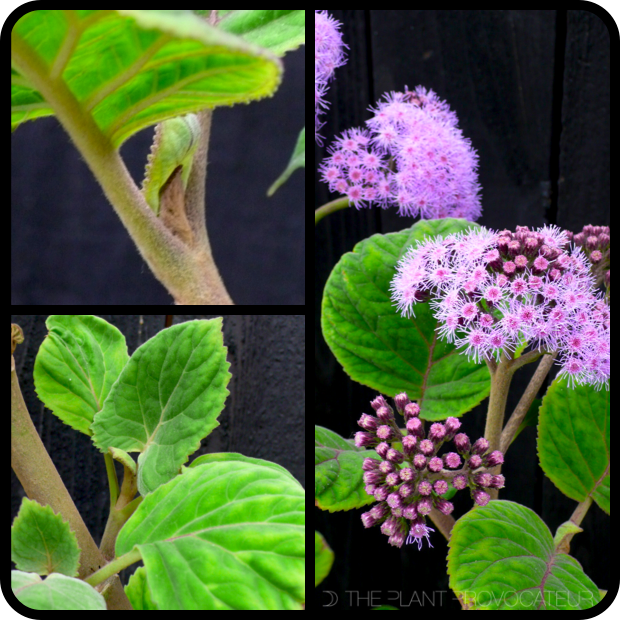
|Bartlettina sordida floral detail|
Imagine a place where the ground touches the sky. A place where the trees catch passing clouds, hold them, and filter their moisture to the environment below. Sounds pretty mystical doesn’t it? Well, in reality, there are a few places in the world where land and cloud converge to create what are known as cloud forests. One such place is Mexico. Cloud forests can be tropical or subtropical. But, in my opinion, it is where they are temperate that things become interesting, especially the plant life they produce. One such amazing specimen perennial shrub to come from the Mexican Cloud Forest is the electrifying Bartlettina sordida also commonly called the Purple Torch or Blue Mist Flower. Look at these flowers. They look like live wires of electric lilac loveliness. Oh, wait…what you are seeing above is only the start of the show.

|Bartlettina sordida in bloom|
SHAZAM! Here are the flowers heads of Bartlettina sordida in full, shag-a-delicately sumptuous, bloom! Seeing it bloom reminds me of watching a firework bursting in slow motion with the end result looking like a luminous cluster of colorful candy floss. The scent that unfurls from these filaments of fantasy is a heavenly combination of luscious lilac with the slightest tones of sweet and spicy honey. The butterflies go gaga for this plant!

|Bartlettina sordida foliage + flower|
I discovered Bartlettina sordida some years ago when I purchased it from Annies Annuals. I planted it in a bright but shady area with great air circulation. In one season it grew into a 4 foot tall and wide shrub. In its second season it grew 8 feet tall. It kicked out some lushly large plush tropical leaves etched in rich rosy purple venation. We’re talking leaves the size of dinner plates! In spring, it produced clusters of tightly bound buds at the ends of its stems. Around April the buds began to burst open and by early May the flower heads were in full effect looking like an electric dream.
Now if you have a bright, shady place that gets good air circulation and has moist, rich, fertile, well-draining soil, then you’ve got a spot for a Bartlettina sordida. This plant likes regular water and appreciates a feeding of fertilizer during the warm, growing season. It is pretty hardy down to about 25/30 degrees fahrenheit or -1/-3 degrees celsius. One thing to note about this Bartlettina is that its foliage gets pretty beat up during the winter months. My suggestion is that come spring, prune any tall, gangly canes of the plant down to just above it’s second stem node and strip any spent leaves. Give it some fertilizer and watch for new shoots. More than likely, it’ll come back even more bushier and luscious than ever. More stem growth means more bloom.
I say, if you’re interested in giving your situation some interesting tropical impact, find yourself a Bartlettina sordida and get growing. It is one plant that radiates a stylishly exotic allure like no other.





























Wow, your photos are amazing!! So vibrant. I wish I could grow a plant like this one in my Minnesota garden. It would definitely have to be a houseplant here.
I’m going to the Garden Blogger’s Fling in San Francisco this summer, and I wanted to stop by and say hi. I’m a first-timer and I can’t wait to meet everyone.
Amy
I too have a Bartlettina sordida that I purchased from Annie’s Annuals and it has been a wonderful addition to my garden. I noted that you stated it is best to prune in the Spring. Mine Bartlettina is looking a bit spent, the flowers have almost all gone to seed, and here in Albany CA with the winds, the flower seeds get spread all around the garden. I’ve never seen any new sprouts from the seeds being spread. My comment more is with respect to pruning. Mine is rather leggy and I want to prune it down but have this habit of being afraid to prune things as I don’t want to kill them…silly because the things I have gone ahead and pruned have always performed better. It is now almost June and I want to prune the plant since Spring is almost over…do you think it is OK for me to give the plant a major pruning now? How far down to the ground can I prune it without risking damage? I appreciate your input as I cannot find any advice on the Internet with respect to proper pruning. Thanks and happy gardening!
Hi Roxy! Here’s my experience from my Berkeley, CA garden. After flowering finished and stems became leggy I pruned mine down to semi-hard wood. Usually taking off about 1/3 to 1/2 of the leggy growth. I made cuts just above stem joints/nodes where new growth could develop. After pruning, I would amend the soil around the plant with steer manure to encourage the newly shorn shrub to take up some organic nutrients and encourage new energy for producing new stems. Continue with regular watering. It worked on most cut stems. Some stems did experience dieback but usually new growth sprang out of the cuts that didn’t. Also, I took my cuttings and placed them in containers of compost. I kept the compost lightly moistened and left these containers in a part sun location in my garden. Of the 4 cuttings, for example, I did this with…2 took and are now the Bartlettinas growing in my Los Angeles garden. If you decide to try this out, let me know how it goes. And if you want a second opinion give the folks at Annies Annuals a call. They may have other suggestions.
Best of luck!
-Hank